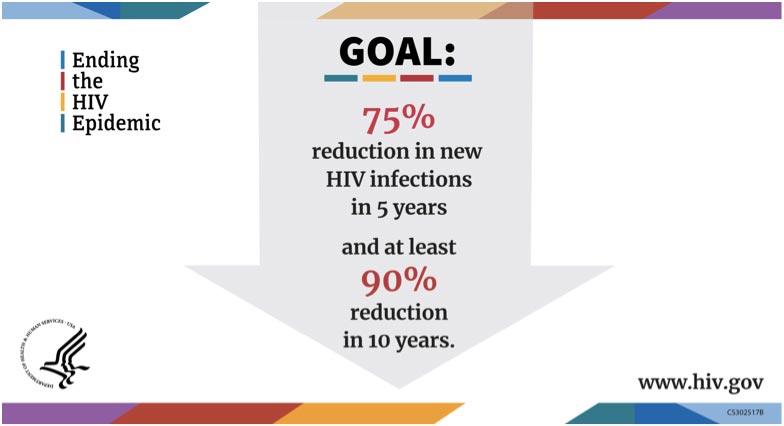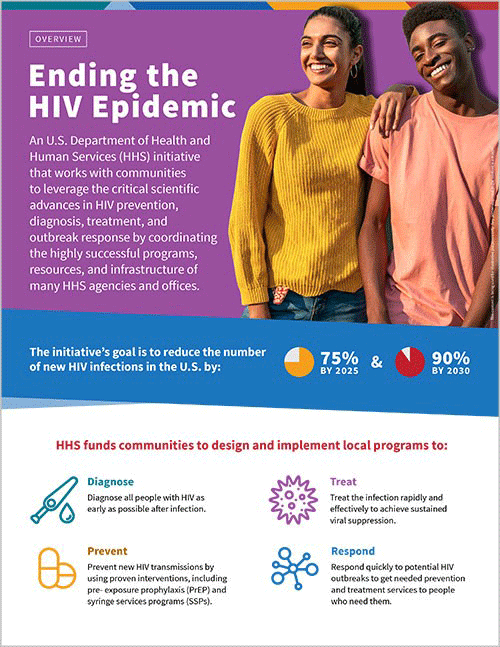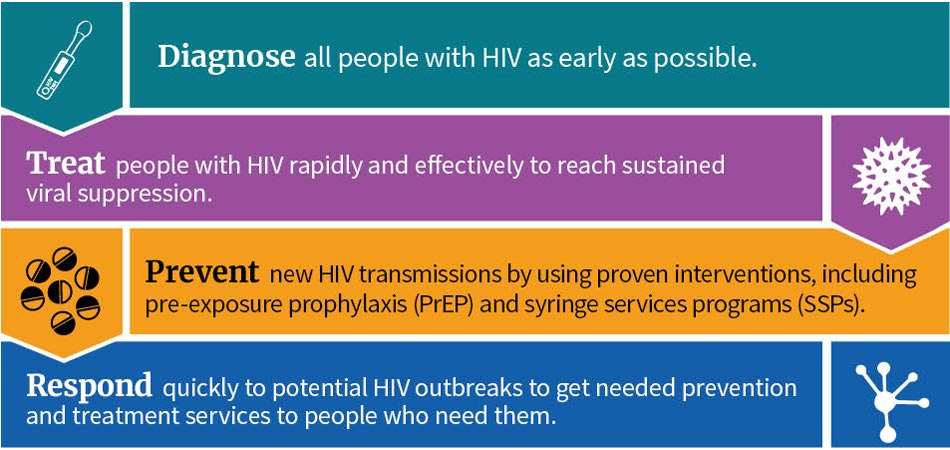What is ‘Ending the HIV Epidemic: A Plan for America’?
Ready, Set, PrEP Program Removes Cost Barrier to Increase Access to PrEP Medications NationwideExit Disclaimer
Ready, Set, PrEP is a new nationwide program led by the U.S. Department of Health and Human Services (HHS). The Ready, Set, PrEP program provides pre-exposure prophylaxis (PrEP) medications at no cost to thousands of individuals who qualify. The program will expand access to PrEP medications, reduce new HIV infections, and bring us one step closer to ending the HIV epidemic in the United States. To check eligibility and enroll in the program click hereExit Disclaimer.
We have a once-in-a-generation opportunity to end the HIV epidemic in the United States. Now is the time.
In the State of the Union Address on February 5, 2019, President Donald J. Trump announced his Administration’s goal to end the HIV epidemic in the United States within 10 years. To achieve this goal and address the ongoing public health crisis of HIV, the proposed Ending the HIV Epidemic: A Plan for America will leverage the powerful data and tools now available to reduce new HIV infections in the United States by 75 percent in five years and by 90 percent by 2030.

Background
HIV has cost America too much for too long and remains a significant public health issue:
- More than 700,000 American lives have been lost to HIV since 1981.
- More than 1.1 million Americans are currently living with HIV and many more are at risk of HIV infection.
- While new HIV diagnoses have declined significantly from their peak, progress on further reducing them has stalled with an estimated 40,000 Americans being newly diagnosed each year. Without intervention another 400,000 Americans will be newly diagnosed over 10 years despite the available tools to prevent infections.
- The U.S. government spends $20 billion in annual direct health expenditures for HIV prevention and care.
- There is a real risk of an HIV resurgence due to several factors, including injection drug use and diagnostic complacency among healthcare providers.
Goal
The new initiative seeks to reduce the number of new HIV infections in the United States by 75 percent within five years, and then by at least 90 percent within 10 years, for an estimated 250,000 total HIV infections averted.
“Today we have the
Right Data, Right Tools, and Right Leadership
to end the HIV epidemic.”
Right Data & Right Tools
Today we have the tools available to end the HIV epidemic. Landmark biomedical and scientific research advances have led to the development of many successful HIV treatment regimens, prevention strategies, and improved care for persons living with HIV.
- Data tell us that most new infections occur in a limited number of counties and among specific populations.
- Thanks to advances in antiretroviral therapy, the medicine used to treat HIV, individuals with HIV who take their medicine as prescribed and, as a result, maintain an undetectable viral load can live long, healthy lives and have effectively no risk of sexually transmitting HIV to a partner.
- We have proven models of effective HIV care and prevention based on over two decades of experience engaging and retaining patients in effective care.
- Pre-exposure prophylaxis (PrEP), a daily regimen of two oral antiretroviral drugs in a single pill, has proven to be highly effective in preventing HIV infection for individuals at high risk, reducing the risk of acquiring HIV by up to 97 percent.
- New laboratory and epidemiological techniques allow us to pinpoint where HIV infections are spreading most rapidly so health officials can respond swiftly with resources to stop the further spread of new infections.
With these powerful data and tools, the Administration sees a once-in-a-generation opportunity to end the epidemic.
Right Leadership
Fact Sheet

English (PDF 211 KB)
This initiative will leverage critical scientific advances in HIV prevention, diagnosis, treatment, and care by coordinating the highly successful programs, resources, and infrastructure of many HHS agencies and offices, including the:
- Centers for Disease Control and Prevention (CDC)
- Health Resources and Services Administration (HRSA)
- Indian Health Service (IHS)
- National Institutes of Health (NIH)
- Office of the HHS Assistant Secretary for Health
- Substance Abuse and Mental Health Services Administration (SAMHSA)
The HHS Office of the Assistant Secretary for Health is coordinating this cross-agency Plan.
Whole-of-Society Initiative
In addition to the coordination of federal agencies, key components for the success of this initiative will be active partnerships with city, county, tribal, and state public health departments, local and regional clinics and healthcare facilities, clinicians, providers of medication-assisted treatment for opioid use disorder, professional associations, advocates, community- and faith-based organizations, and academic and research institutions.
Budget Request
President Trump proposed $291 million in the FY2020 HHS budget to begin his Administration’s multiyear initiative focused on ending the HIV epidemic in America by 2030.
Phase I: Geographic Focus
Most new HIV infections in the United States are highly concentrated in certain geographic hotspots. More than 50 percent of new HIV diagnoses in 2016 and 2017 occurred in 48 counties, Washington, DC, and San Juan, Puerto Rico. We also know that seven states have a disproportionate occurrence of HIV in rural areas. For the first five years (Phase I), the initiative will focus on a rapid infusion of new resources, expertise, and technology into those parts of the country now most impacted by HIV.

Phases II and III
In Phase II, efforts will be even more widely disseminated across the nation to reduce new infections by 90 percent by 2030. In Phase III, intensive case management will be implemented to maintain the number of new infections at fewer than 3,000 per year.
Challenges
Despite the game-changing developments in HIV prevention and treatment tools, not everyone is benefiting equally from these advances. New infections are highly concentrated among men who have sex with men; minorities, especially African Americans, Hispanics/Latinos, and American Indians and Alaska Natives; and those who live in the southern United States.
Further, new analysis from CDC shows the vast majority (about 80 percent) of new HIV infections in the U.S. in 2016 were transmitted from the nearly 40 percent of people with HIV who either did not know they had HIV, or who had been diagnosed but were not receiving HIV care. These data underscore the impact of undiagnosed and untreated HIV in the nation and also the critical need to expand HIV testing and treatment in the United States.
 Take action to end the epidemic. Encourage testing and help others access this HIV services tool.
Take action to end the epidemic. Encourage testing and help others access this HIV services tool.And stigma—which can be a debilitating barrier preventing people living with, or at risk for, HIV from receiving the health care, services, and respect they need and deserve—still tragically surrounds HIV. Responding to HIV is not just a biomedical issue, but a social challenge, too.
Effective interventions have driven the number of new HIV infections down to approximately 40,000 per year—the lowest level ever. However, recent data show that our progress reducing the number of new HIV infections has plateaued. Now there are new threats to the progress we’ve made, the most significant being the opioid crisis: One in 10 new HIV infections occurs among people who inject drugs.
Key Strategies in the Plan
Ending the HIV Epidemic: A Plan for America will provide the hardest hit communities with the additional expertise, technology, and resources required to address the HIV epidemic locally.
The Plan's major areas of action include:
- Increasing investments in geographic hotspots through our existing, effective programs, such as the Ryan White HIV/AIDS Program, as well as a new program through community health centers that will provide PrEP to protect people at highest risk for getting HIV.
- Using data to identify where HIV is spreading most rapidly and guide decision-making to address prevention, care, and treatment needs at the local level.
- • Supporting the jurisdictions to establish local teams committed to the success of the Initiative and expand HIV prevention and treatment services.
The efforts will focus on four key strategies that together can end the HIV epidemic in the U.S.: Diagnose, Treat, Prevent, and Respond.

Diagnose all individuals with HIV as early as possible. Approximately 165,000 Americans are living with HIV but don’t know they have it. Early detection is critical and can lead to quicker results in treatment and prevent transmission to others. Using the latest diagnostics and advanced automation systems, we will make HIV testing simple, accessible, and routine. And we will diagnose infection early and connect people with HIV immediately to care.
Treat people with HIV rapidly and effectively to reach sustained viral suppression. People with HIV who take medication as prescribed and stay virally suppressed can live long, healthy lives and have effectively no risk of sexually transmitting HIV to a partner. Eighty percent of annual new infections are transmitted by those living with HIV who are not receiving HIV care and treatment. We will establish and expand programs to follow up with people with HIV no longer receiving care—and provide the resources needed to re-engage them in effective HIV care and treatment. The Ryan White HIV/AIDS Program has achieved a viral suppression rate of nearly 86 percent. We aim to leverage the program’s comprehensive system of care and treatment to increase viral suppression around the country to 90 percent.
Prevent new HIV transmissions by using proven interventions, including PrEP and syringe services programs (SSPs).Of the estimated 1 million Americans at substantial risk for HIV and who could benefit from PrEP, less than 1 in 4 are actually using this medication. In May 2019, HHS and Gilead Sciences announced that the pharmaceutical company has agreed to donate PrEP medication for up to 200,000 individuals each year for up to 11 years. HHS will make the medication available to individuals who are at risk for HIV and who are uninsured and might otherwise not be able to access or afford this powerful HIV prevention tool. In addition, SSPs are an effective component of a comprehensive, integrated approach to HIV prevention among people who inject drugs. Nearly 30 years of research has shown that comprehensive SSPs are safe, effective, and cost-saving, do not increase illegal drug use or crime, and play an important role in reducing the transmission of viral hepatitis, HIV and other infections.
Respond quickly to potential HIV outbreaks to get needed prevention and treatment services to people who need them. New laboratory methods and epidemiological techniques allow us to see where HIV may be spreading most rapidly, thereby allowing CDC and other partners to quickly develop and implement strategies to stop ongoing transmission. We will work with impacted communities to ensure they have the technology, personnel, and prevention resources to follow up on all HIV cases and to intervene to stop chains of transmission, and to get those impacted into appropriate care and treatment.
